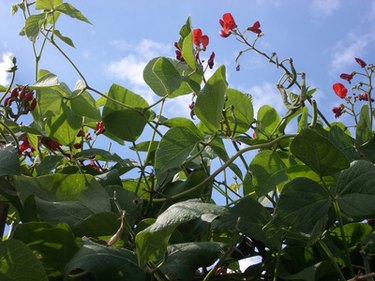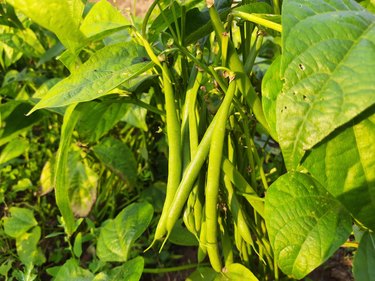
Beans are often touted as a good entry-level plant for new gardeners, with relatively low levels of care and high produce yields, but when green bean leaves start turning brown and falling off, it's time to take action. However, this is an identifiable problem with a solution – once you notice brown leaves on bean plants, act quickly, and you may be able to save the plants.
Green Bean Leaves Turning Brown
Video of the Day
A brown spot on a leaf means something different than the leaf growing brown at the edge and curling; a yellow lining around the brown spots means another thing. Browning leaves are generally caused by bacterial infection – the cause of this is almost always infected seeds, but the bacteria inside the seed can live on in the soil for up to two years once introduced. Preventative measures include always buying new seeds from reputable sources whenever planting beans, rotating crops to sow beans no more often than every third year on any plot of land, and avoiding overhead watering methods.
Video of the Day
Copper fungicides – used no more than every 10 days – can treat the symptoms of some fungal blights until harvest, but the most effective practice is to carefully extract the affected plants and the surrounding two feet of soil, then bagging and trashing the plant and soil or burning it at a safe distance.
Root rot and rust fungus are two other possible causes of browning leaves. These can be prevented by avoiding overwatering your plants, ensuring good drainage and applying approved fungicides as needed.
Do Insects Cause Browning Leaves?

Neither runner bean nor bush bean pests cause the browning of leaves. Although there are exhaustive lists that detail all the pests that affect beans as well as diseases and fungal infections, browning leaves is not a symptom caused by a pest – although pests can cause lums, which are holes and yellow discolorations on the leaf .
Some nematodes can form colonies in bean plant roots, which will create cysts blocking nutrient uptake. This can cause withered and yellowing leaves, smaller bean pods or no flowering and fruiting at all, but not browning leaves. Additionally, most bean plants are inoculated with a kind of beneficial symbiotic fungus which will fight off nematodes (called rhizobia), which also help beans to fix nitrogen in the soil.
Improving Nutrients in Your Soil
Nitrogen fixing is an important role all legumes can perform to one degree or another, and plowing bean plants back into the soil after harvest is one way you may improve the nitrogen available in the soil as you rotate crops through a plot. Buckwheat and radishes are known to similarly fix phosphorus.

However, potassium, which rounds out the big three nutrients plants use and need, is harder to fix in the soil. Potash serves to increase available potassium, but there are no known plants that appropriately fix potassium into the soil.
One final way that you can improve nutrients in your soil is by planting legumes and buckwheat; legumes and buckwheat serve to concentrate known pools of nutrients and make them available as decomposing plant matter is tilled back into the soil.